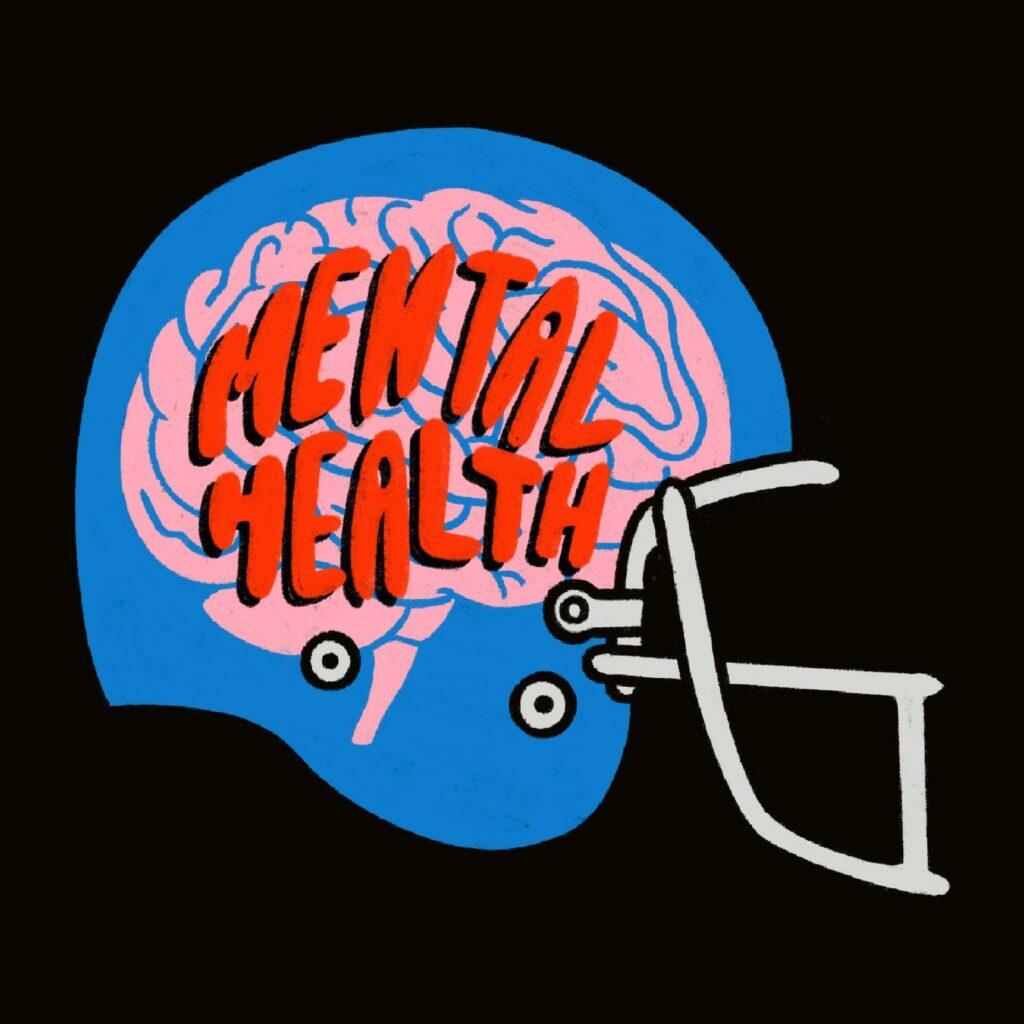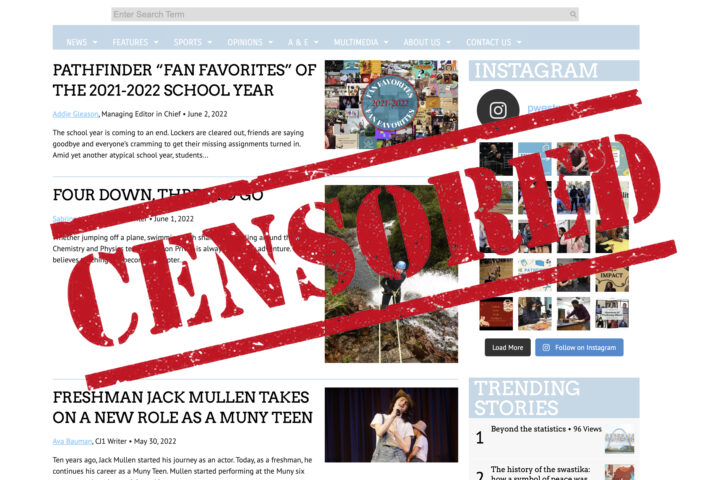It’s a Friday night in October, and I’m standing on the bleachers that overlook my high school’s football field. Surrounded by what feels like the entirety of my small suburban town, the energy of the crowd filling the bleachers and watching their idols is palpable. It’s a close game, and every play evokes “ooh-s” and “ahh-s” from the excited crowd. I know most of the boys on the field — some from math class, others from elementary school. But it wouldn’t matter if I didn’t, because their names are constantly echoing throughout the stadium as the announcer gives play-by-play commentary of the game loud enough for every bordering town to hear. I’m following along with the rest of the crowd as the game happens below me, cheering when I’m supposed to and booing every call that the referees make against our team, regardless of whether or not it’s warranted.
As I’m standing there, under lights bright enough to make me forget that it’s 8 pm in October, I wonder what the players are thinking. As a lifelong competitive athlete, I’ve been in their position plenty of times. Though women’s lacrosse doesn’t have quite the same allure for fans as football seems to, the feeling of being at the epicenter of community activity when you’re the one playing on the field—representing your town or school—is one that every athlete has experienced. It’s easy to forget how much pressure comes with trying to entertain a crowd of that size, not to mention the pressure of trying not to disappoint them.
This dynamic isn’t exclusive to suburban towns who seem to care a little too much about their pee-wee football program – it’s the dark side of sports that every athlete knows, regardless of the level at which they play. It’s the elephant in the room when we’re having conversations about athlete well-being, and in 2022, the global world of sport took a step in the right direction by acknowledging that we can no longer afford to ignore the bleak statistics that reflect the way athletes, at every level, are being emotionally neglected. We’ve had enough conversations about the mental health conversation. In 2023, it’s urgent that the world of sports–namely the organizations that hold the most power and influence–take action to prioritize the mental well-being of athletes of all ages. We can do this by shifting the narrative about what resilience looks like, reimagining how society incentivizes athletic performance, and creating legislation that protects athletes, thereby protecting the integrity of sport.
Sports are a unique social phenomenon. Aside from politics, few things seem to have the ability to bring strangers together, or pit them against one another in the way that sports do at every level of play. The collective cheering and booing that occurs among fan sections is a bonding experience. The high fives shared between strangers from Little League Baseball games to NBA playoffs are a demonstration of the cultural power that sports have to connect communities. Sporting events, fantasy football, the excitement of the Olympic Games coming around—they’re a welcome distraction from heavy societal realities. Whether we honor it or not, sports are far more than the one or two hours of competition that we watch; they are an indispensable part of global history and international connectedness. Sports are integral to the fabric and formation of communities, adolescent development, and morale for athletes and fans of all ages, backgrounds, and demographics.
For the better part of a century, student athletes have done the work of connecting communities, schools, and society at large. But there exists a paradox in the way American society both embraces sports and rejects failure simultaneously: The same athletes who perform the civic responsibility of uniting their communities are also the ones who bear the burden of that pressure. Democracy takes place in the stands of sporting events; the bleachers a sort of secular church, housing people with a plurality of backgrounds. It’s a beautiful thing, and it’s also a big deal for the people who make it happen: the athletes.

Feeling like you’re constantly under the lights, both on and off of the field, takes a toll on athletes’ confidence, sense of worth, and perspective of the world around them. Until recently, the discussion of psychology in sports rarely extended beyond psychological mechanisms for gaining an advantage over your opponent. For a profession that has been expanding rapidly since the 1920s, the avenues that sports psychology has relied on to “better” athletes have unfortunately done very little to address the mental health crisis that has overwhelmed the American athletic community over the past two decades. As the intensity of sports is projected onto athletes at increasingly younger ages, so too is the pressure. Given the relevance of sports in American culture, it is a matter of civic urgency that in the coming year we not only have conversations about mental health in sports, but also that we go further by taking action to optimize protocols, training, legislation, and funding in a way that prioritizes the wellbeing of athletes instead of simply their performance.
When I wrote A Letter to College Sports in April of 2022, my call to reimagine the way that mental health is understood in sports was primarily targeting college communities, coaches, and parents of student-athletes. While this is the population that has been at the forefront of the mental health crisis in recent years, my pursuit of actionable changes in the culture of sports remains in tension with the longstanding history of the “win-at-all-costs” culture that has historically dominated attitudes in the world of sports. This isn’t unique to college athletics, so the conversation and prioritization of mental health must extend further in order to create actual, visible change in the ways our society understands, talks about, watches, and plays sports at large. This means extending the conversation to everyone involved in sports, ranging from municipalities organizing youth sports programs, to high school athletic directors, all the way to corporations like Nike and Under Armour who have historically defined attitudes and perceptions of fans and athletes globally.
If we are truly to address the foundation of poor mental health among college and professional athletes, we must begin where the athletes themselves did: in their hometowns, on their youth teams, under parent-coaches and competitive club programs. Therein lies the origins of the mental health dynamics we see among athletes at the highest level: the lacking sense of worthiness, the perceived promise of validation through athletic success, body image challenges, limited independence, the fear of failure and the celebration of “mental toughness.” As the visibility of mental health experiences in sports is increasing at the professional and collegiate level, neglecting the populations of young athletes who are in the early stages of conceptualizing what that means for their identity will only continue the mental health crisis in generations of athletes to come.
In the past few years, we’ve seen globally-renowned athletes come forward about mental health challenges and be outspoken about prioritizing their wellbeing over their sport, with Naomi Osaka, Simone Biles, and Michael Phelps among them. It’s clear that we’re witnessing an opportunity to shift sports culture from being rigid and unforgiving to being something that actually serves athletes. The question we face now is: How can we as athletes, coaches, fans, school board members, and policymakers facilitate this shift? What can we do to make sure that this shift isn’t a shallow performance of caring about mental health for the sake of being “on trend”? How can we make it so that athletes who come forward about struggling with their mental health are championed for their advocacy rather than punished for their vulnerability?
As a twenty-year-old, I don’t have all of the answers to these questions. Still, I’m confident that facilitating this shift starts at the local level, on high school teams and in carpools to practice, where children are learning what it means to be an athlete. Rather than emphasizing and celebrating accolades or A-team players, we need to emphasize what children and young adults can learn from playing a sport, whether that is increased self-esteem from overcoming challenges, becoming the best teammate they can be, or learning leadership skills. At the collegiate and professional level, we need to increase the visibility of mental health struggles as being normal, so that athletes don’t feel like coming out about their poor mental health is a sign of weakness or dramatics. On a cultural level, it’s imperative that we collectively take a step back from the emphasis on winning and losing, and individual success in sports, and recognize that sports are not worth the entertainment if they cost athlete wellbeing. The bottom line holds: if we want sports to be an enriching experience for athletes and fans alike, and remain a part of public life in the United States, it is our civic responsibility to create programs, policies, and protocols to support the athletes who provide that experience.



